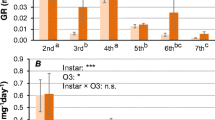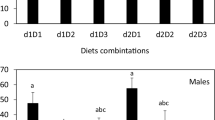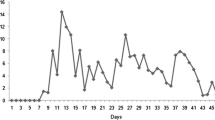Abstract
In quantitative feeding experiments, larvae of Grammodes stolida (Fab) consumed significantly more of mature leaves than young and senescent leaves of Lannea coromandelica (Houtt). The maximum leaf consumption was by the third instar. The amount of food consumed by the penultimate and final instars comprised 72.6% of the total larval consumption. Food utilisation indices, namely approximate digestibility (AD), efficiency of conversion of ingested food (ECI), and efficiency of conversion of digested food (ECD) showed a significant decrease during the second larval stage. The bionomics of the moth were studied in relation to its survivability and reproductive potential on Lannea coromandelica which appears to be a potential host which the pest could colonise during periods of non-availability of other crop hosts.
Résumé
Dans des expériences quantitatives d’alimentation, des larves de Grammodes stolida (Fab) ont consommé significativement plus de feuilles mûres que de feuilles jeunes ou vieillissantes de Lannea coromandelica (Houtt). Le maximum de consommation folière était chez le troisième stade. La quantité de nourriture consommée par les stade pénultième et terminaux comprenait 72.6% de la consommation larvaire totale. Les indices d’utilisation de nourriture, à savoir la digestiblilité approximative (D A), l’efficience de conversion de la nourriture ingérée (ECI), efficience de conversion de la nourriture digérée (ECD) ont montré une diminution significative pendant le deuxième stade larvaire. La bionomie de la phalène a été étudiée en rapport avec sa survie et son potentiel de reproduction sur Lannea coromandelica qui semble être un hôte potentiel que le ravageur pourrait coloniser pendant les périodes d’indisponibilité d’autres plantes.
Similar content being viewed by others
References
Applebaum S. W. (1985) Biochemistry of digestion, pp. 279–311. In Comprehensive Insect Physiology, Biochemistry and Pharmacology Vol. 4 (Edited by G. A. Kerkut and L.I. Gilbert). Pergamon Press, Oxford.
Bailey C. G. (1976) A quantitative study of consumption and utilization of various diets in the bertha army worm, Mamestra configurata (Lepidoptera: Noctuidae). Canad. Ent. 108, 1319–1326.
Brattsten L. B. and Ahmad S. (1986) Molecular Aspects of Insect-Plant Associations. Plenum Press, N. York and London. 346 pp.
Brewer J. W., Capinera L. L., Deshan R. E., Jr. and Walmsley M. L. (1985) Influence of foliar nitrogen levels on survival, development and reproduction of western spruce budworm, Choristoneura occidentalis (Lepidoptera: Torticidae). Can. Ent. 117, 23–32.
Broadway R. M. and Duffey S. S. (1986) The effect of dietary protein on the growth and digestive physiology of larval Heliothis zea and Spodoptera exigua. J. Insect Physiol. 32, 673–680.
Cates R. G., Redak R. A. and Henderson C. B. (1983) Natural products defensive chemicals of Douglasfir, western spruce budworm success, and forest management practices. Z. Angew. Entomol. 96, 173–182.
Coley P. D. (1980) Effects of leaf age and plant life history patterns on herbivory. Nature 284, 545–546.
Crawley M. J. (1983) Herbivory: The Dynamics of Animal-Plant Interactions. University of California Press, Berkeley and Los Angeles. 437 pp.
Feeny P. D. (1970) Seasonal changes in oak leaf tannins and nutrients as a cause of spring feeding by winter moth caterpillars. Ecology 51, 565–581.
Finch S. (1980) Chemical attraction of plant-feeding insects to plants. Appl. Biol. 5, 67–143
Hill D. S. (1987) Agricultural Insect Pests of the Tropics and their Control. Cambridge Univ. Press. 740 pp.
Humphries E. C. (1956) Mineral Compounds and Ash Analysis in Modern Methods of Plant Analysis, pp. 237–248 (Edited by K. Peach and M. V. Tracey). Springer Verlag, Berlin.
Lance D. R. (1983) Host-seeking behaviour of gypsy moth: The influence of polyphagy and highly apparent host plants, pp. 201–224. In Herbivorous Insects: Host Seeking Behaviour and Mechanisms (Edited by S. Ahmad). Academic Press, New York.
Mattson W. J., Jr. (1980) Herbivory in relation to nitrogen content. Annu. Rev. Ecol. Syst. 11, 119–162.
McNeill S. and Southwood T. R. E. (1978) The role of nitrogen in the development of insect plant relationships, pp. 77–98. In Biochemical Aspects of Plants and Animal Co-evolution (Edited by J. B. Harbone). Academic Press, London.
Miller J. R. and Strickler K. L. (1984) Finding and accepting host plants, pp. 127–157. In Chemical Ecology of Insects (Edited by W. J. Bell and R. T. Carde). Chapman and Hall, London and New York.
Niemela P., Tuomi J. and Haukioja E. (1980) Age specific resistance in trees: Defoliation of Tamaracks (Larix laricina) by larch bud moth (Zeiraphera improbana) (Lepidoptera: Tortricidae). Rep. Kevo. Subarct. Res. Stn. 16, 49–57.
Patho P. D., Sanjayan K. P. and Muralirangan M. C (1993) Influence of host nitrogen on the reproductive biology of Oxyafuscovittata (Orthoptera: Acrididae). Proc. Indian Natn. Sci. Acad. 59, 483–487.
Premkumar M., Dale D. and Nair M. R. G. K. (1977) Consumption, digestion and utilization of food by larvae of Spodoptera litura F. (Lepidoptera: Noctuidae). Entomon 2, 7–10.
Prokopy R. J., Collier R. H. and Finch S. (1983) Leaf color: A character used by cabbage root flies to distinguish among host plants. Science 221, 190–191.
Rana B., Prasad B. and NigamM. P. (1987) Consumption and utilization of food by oak-tasar silkworm Antheraea proylei Jally (Lep.: Satur.). Sericologia 27, 11–19.
Rosenthal G. A. and Janzen D. H. (1979) Herbivores: Their Interaction with Secondary Plant Metabolites. Academic Press, N. York. 718 pp.
Sanjayan K. P., Muralirangam M. C., Suresh P., Suresh Chand D. and Albert S. (1995) The plant community structure of the Nanmangalam Reserve Forest, Tamil Nadu: A paradigm of the spatial distribution pattern in a natural scrub-jungle ecosystem. Int. J. Eco. Environ. Sci. 21, 297–307.
Schowalter T. D., Hargrone W. W. and Crossley D. A., Jr. (1986) Herbivory in forested ecosystem. Annu. Rev. Entomol. 31, 177–196.
Schroeder L. A. (1986) Protein limitations of a tree feeding lepidopteran. Entomol. Exp. Appl. 41, 115–120.
Schultz J. C. (1983) Habitat selection and foraging tactics of caterpillars in heterogenous trees, pp. 61–91. In Variable Plants and Herbivores in Natural and Managed Systems (Edited by R. F. Denno and M. S. McClure). Academic Press, New York.
Scriber J. M. (1977) Limiting effects of low leaf-water content on the nitrogen utilization energy budget and larval growth of Hyalophora cecropia. Oecologia 28, 269–287.
Slansky F., Jr. and Feeny P. (1977) Stabilization of the rate of nitrogen accumulation by larvae of the cabbage butterfly on wild and cultivated food plants. Ecol. Monogr. 47, 209–228.
Slansky F., Jr. and Scriber J. M. (1985) Food consumption and utilization, pp. 87–164. In Comprehensive Insect Physiology, Biochemistry and Pharmacology Vol. 4 (Edited by G. A. Kerkut and L. I. Gilbert). Pergamon Press, Oxford.
Waldbauer G. P. (1968) The consumption and utilization of food by insects. Adv. Insect Physiol. 5, 229–288.
Whitham T. G. (1981) Individual trees as heterogenous environments: Adaptation to herbivory or epigenetic noise?, pp. 9–27. In Insect Life History Patterns: Habitat and Geographic Variations (Edited by R. F. Denno and H. Dingle). Springer-Verlag, Berlin and NY.
Wightman J. A. (1978) The ecology of Callosobruchus analis (Coleoptera: Bruchidae): Morphometries and energetics of the immature stages. J. Anim. Ecol. 47, 117–129.
Yadava P. S., Vats L. K. and Kaushal B. R. (1979) Food consumption, assimilation and growth in the larvae of Pienis brassicae Linn. J. Anim. Physiol. 26, 257–264.
Author information
Authors and Affiliations
Rights and permissions
About this article
Cite this article
Sanjayan, K.P., Suresh Chand, D. Nutritional Preferences of Grammodes stolida (Fab), a Defoliator of the Forest Tree, Lannea coromandelica (Houtt). Int J Trop Insect Sci 17, 257–263 (1997). https://doi.org/10.1017/S1742758400016453
Accepted:
Published:
Issue Date:
DOI: https://doi.org/10.1017/S1742758400016453
Keywords
- Lannea coromandelica
- Grammodes stolida
- feeding preference
- nitrogen utilisation
- spatial distribution
- noctuid




